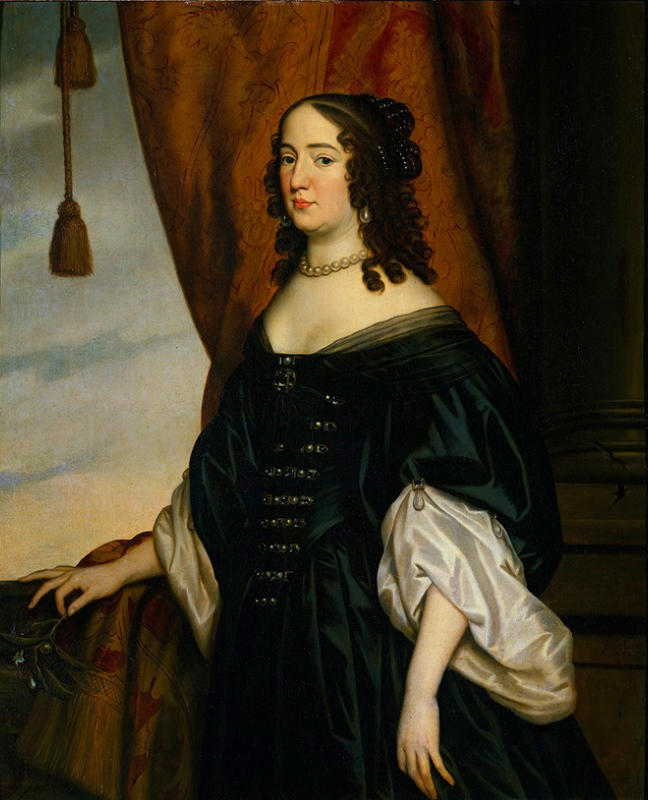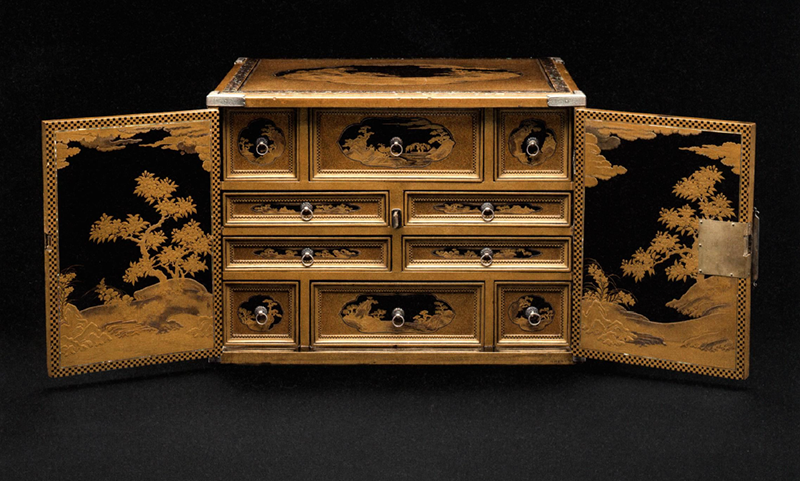Chinese Porcelain and Japanese Lacquerware in the Cabinets of Amalia van Solms-Braunfels
by Lauryn Smith
In the early modern period, wealthy and elite individuals began amassing extraordinary collections, composed of both locally produced and imported works of art. Few were as innovative as Amalia van Solms-Braunfels (1602–1675), Princess of Orange (figure 1). Under Amalia and her husband, Stadtholder Frederik Hendrik (1584–1647), Prince of Orange, the United Provinces (modern-day Netherlands) flourished as a cultural and global power.
The strength and wealth of the country, and by association the House of Orange-Nassau, is embedded in Amalia’s cabinets or closets, private spaces where she carefully curated assemblages of decorative and fine art. My dissertation examines these rooms to investigate how Amalia employed objects within the most intimate spaces of her residences to construct her various identities—as wife, mother, consort, princess, and later widow—and further the status and prestige of the House of Orange-Nassau. Alongside paintings by Rembrandt van Rijn and Peter Paul Rubens, Amalia displayed distinctively Dutch silver, German amber, naturalia, and a range of objects imported or comprised of raw materials from East and West Asia, islands in the Atlantic, and the Americas, thereby representing the breadth of Dutch colonial pursuits. Of Amalia’s collection of imported art, the majority originated from East Asia and included a vast assortment of textiles, ceramics, metalwork, and furniture.
The study of Amalia’s collections is greatly hindered by the lack of known surviving examples. After her death in 1675, the majority of Amalia’s magnificent holdings was inherited by her three living daughters and two of her grandsons. Her descendants continued to build upon these inherited collections, making it difficult to ascertain which objects were once hers. To overcome this obstacle, my dissertation relies heavily on the extant inventories of Amalia’s possessions from 1632–1676.1 With the assistance of a Decorative Art Trust Research Grant, I embarked on a week-long research trip to the Peabody Essex Museum (PEM) and Museum of Fine Arts, Boston (MFA) to closely study Chinese porcelain, Japanese lacquerware, and Indian mother-of-pearl artwork similar to those passionately collected by Amalia. Armed with my transcriptions of Amalia’s inventories, I spent a week closely examining representative objects and thinking critically about the embodied experience of owning them.
PEM possesses an extraordinary array of export Asian art that was disseminated throughout Europe during the early modern period. I was fortunate to handle examples of Chinese porcelain and converse with Karina Corrigan, Associate Director of Collections and the H.A. Crosby Forbes Curator of Asian Export Art. Amalia’s porcelain holdings grew from just a few hundred pieces in 1632 to over 1,200 by 1675. Most of her acquisitions consisted of dinnerware, teapots, and flowerpots, but Amalia also sought out unique and novel forms and was possibly one of the earliest Europeans to obtain Dehua porcelain, also known as Blanc de Chine. I closely analyzed a number of Chinese porcelain objects, including a stunning example of an elephant-shaped Kendi (figure 2) that is similar to the one described in the princess’s inventories. Amalia’s ability to acquire imported Asian wares in great quantities illuminates the relationship between China, Japan, Dutch colonies in Asia, and the United Provinces that was formed during the early 17th century. The Dutch East Company (Vereenigde Oostindische Compagnie, or VOC) actively sought the influence of Amalia and frequently put aside their finest and most unusual pieces of porcelain to gift to her.2 My examination at PEM offered the opportunity to consider how Chinese porcelain enchanted and fascinated Europeans, both individually and in the massed displays that became increasingly popular towards the end of the 17th century.
I also visited PEM’s new Collection Center, where I analyzed an extraordinary Japanese lacquer chest. With the assistance of Don McPhee, Senior Collection Manager, I was able to witness the chest being opened to reveal its decorated interior and ten, red lacquered drawers (figure 3). True lacquer was incredibly expensive and time-consuming to import from Japan, making Amalia’s assemblage of dozens of lacquer coffers and chests exceptional. While lacquerwares were highly sought after for their aesthetic qualities, they were also durable, functional objects. Fireproof and waterproof, they are an excellent option for storing important documents and precious objects. As lacquer began to play a more prominent role in her interiors, the princess utilized her close connection to the VOC to commission custom pieces from Japan, such as a balustrade intended for her bedchamber in Huis ten Bosch.3 By the 1650s, Amalia fully eschewed lacquer’s functionality for its aesthetic qualities, instructing craftspeople to disassemble numerous chests and coffers and use the panels to envelop the walls of her cabinet at Huis ten Bosch. The Rijksmuseum houses the only known extant lacquer room from this period (figure 4), which was installed in the apartments of Amalia’s granddaughter, Henriëtte Amalia van Anhalt-Dessau (1666–1726), in Leeuwarden later in the 17th century.
The remarkable opportunity to interact with different examples of Chinese ceramics and Japanese lacquer has deeply impacted my understanding of the embodied experience of owning, engaging, and displaying these objects. This object-based research has enriched my study on Amalia’s collection of imported decorative art, as well as deepened my understanding of the myriad ways they were used by Europeans, particularly women, to shape and reflect their identities, beliefs, and world views.
- S.W.A. Drossaers and T. Th. Lunsingh-Scheurleer, Inventarissen van de inboedels in de verblijven van de Oranjes en daarmede gelijk te stellen stukken. 3 vols. (The Hague: Martinus Nijhoff, 1974-1976).
- T. Volker, Porcelain and the Dutch East India Company. As Recorded in the Dagh-Registers of Batavia Castle, Those of Hirado and Deshima and Other Contemporary Papers 1602–1682 (Leiden: Brill, 1954), 15-19.
- Cynthia Viallé, “Two boxes and two balustrades: private orders for fine Japanese export lacquer,” in East Asian Lacquer. Material Culture, Science and Conservation, edited by Shayne Rivers, Rubert Faulkner and Boris Pretzel, 26-29 (London: Archetype Publications, in association with the V&A, 2011), 27-8. The lacquered balustrade was disassembled during the 18th century, with some pieces being incorporated into furniture cabinets.
Lauryn Smith is a recent graduate of the Case Western Reserve University/Cleveland Museum of Art Joint Doctoral Art History Program and is a Digital Art History Fellow at the Frick Collection and Frick Art Reference Library.
A print version of this article was published in The Magazine of the Decorative Arts Trust, one of our most popular member benefits. Join today!




